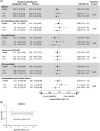Efficacy and safety outcomes of dulaglutide by baseline HbA1c: A post hoc analysis of the REWIND trial
- PMID: 35546279
- PMCID: PMC9543284
- DOI: 10.1111/dom.14760
Efficacy and safety outcomes of dulaglutide by baseline HbA1c: A post hoc analysis of the REWIND trial
Abstract
Aim: To assess cardiovascular, glycaemic, weight and safety outcomes of long-term treatment with dulaglutide 1.5 mg compared with placebo in patients with a baseline HbA1c of less than 7% versus 7% or higher.
Materials and methods: Intention-to-treat analyses were performed on REWIND participants with a baseline HbA1c measurement, using Cox proportional hazards regression and mixed model for repeated measures. Subgroup analyses with factors for baseline HbA1c categories and their interaction with treatment group, as well as analyses within the HbA1c subgroups, were conducted. Additionally, sensitivity analyses were performed for baseline HbA1c subgroups of 6.5% or less and more than 6.5%.
Results: Of the 9876 eligible participants, 3921 and 5955 had a baseline HbA1c of less than 7% and 7% or higher, respectively. Mean baseline HbA1c was 6.3% and 8.0% and the mean duration of diabetes was 9.0 and 11.6 years in the respective subgroups. The less than 7% subgroup was slightly older and less frequently insulin-treated. There was no evidence of a differential dulaglutide treatment effect on body mass index (BMI) reduction, cardiovascular or safety outcomes of interest between the baseline HbA1c subgroups. Treatment-by-baseline HbA1c group interaction was significant for HbA1c change from baseline (P < .001), with a greater reduction in the subgroup with higher baseline HbA1c values. Sensitivity analyses by baseline HbA1c subgroups of 6.5% or less and more than 6.5% showed similar results.
Conclusions: The reduced incidence of cardiovascular events, and the reduction in BMI in participants treated with once-weekly dulaglutide, were independent of the baseline HbA1c level. Conversely, participants with a higher baseline HbA1c level had greater reductions in HbA1c. Dulaglutide has a positive benefit-risk profile and can be considered in patients with comparatively well-controlled HbA1c levels seeking optimal metabolic control and cardiovascular benefits.
Trial registration: ClinicalTrials.gov NCT01394952.
Keywords: cardiovascular disease; clinical trial; dulaglutide; glycaemic control; incretin therapy; type 2 diabetes.
© 2022 Eli Lilly and Company. Diabetes, Obesity and Metabolism published by John Wiley & Sons Ltd.
Conflict of interest statement
EF has acted as an advisor to AstraZeneca, Boehringer Ingelheim, Novo Nordisk, and Polfa Tarchomin, and reports honoraria for speaking from AstraZeneca, Bioton, Boehringer Ingelheim, Eli Lilly and Company, Novo Nordisk, Polfa Tarchomin, Sanofi, and Servier. HCG holds the McMaster‐Sanofi Population Health Institute Chair in Diabetes Research and Care. He reports research grants from Eli Lilly and Company, AstraZeneca, Merck, Novo Nordisk, and Sanofi; honoraria for speaking from AstraZeneca, Boehringer Ingelheim, Eli Lilly and Company, Novo Nordisk, and Sanofi; and consulting fees from Abbott, AstraZeneca, Boehringer Ingelheim, Eli Lilly and Company, Merck, Novo Nordisk, Janssen, Sanofi, and Kowa. MCR reports grants to his institution from Eli Lilly and Company, AstraZeneca, and Novo Nordisk; honoraria for consulting from Adocia, DalCor, GlaxoSmithKline, and Theracos; and honoraria for speaking from Sanofi. LSL, CN, AH, and FTB are employees and stockholders of Eli Lilly and Company.
Figures



Similar articles
-
Exploring potential mediators of the cardiovascular benefit of dulaglutide in type 2 diabetes patients in REWIND.Cardiovasc Diabetol. 2021 Sep 25;20(1):194. doi: 10.1186/s12933-021-01386-4. Cardiovasc Diabetol. 2021. PMID: 34563178 Free PMC article. Clinical Trial.
-
Effect of once-weekly dulaglutide on glycated haemoglobin (HbA1c) and fasting blood glucose in patient subpopulations by gender, duration of diabetes and baseline HbA1c.Diabetes Obes Metab. 2018 Feb;20(2):409-418. doi: 10.1111/dom.13086. Epub 2017 Oct 5. Diabetes Obes Metab. 2018. PMID: 28817231 Free PMC article. Clinical Trial.
-
Efficacy and safety of LY3298176, a novel dual GIP and GLP-1 receptor agonist, in patients with type 2 diabetes: a randomised, placebo-controlled and active comparator-controlled phase 2 trial.Lancet. 2018 Nov 17;392(10160):2180-2193. doi: 10.1016/S0140-6736(18)32260-8. Epub 2018 Oct 4. Lancet. 2018. PMID: 30293770 Clinical Trial.
-
Dulaglutide in the treatment of adult type 2 diabetes: a perspective for primary care providers.Postgrad Med. 2016 Nov;128(8):810-821. doi: 10.1080/00325481.2016.1218260. Epub 2016 Aug 12. Postgrad Med. 2016. PMID: 27488824 Review.
-
Efficacy and safety of dulaglutide compared with glargine in patients with type 2 diabetes: A systematic review and meta-analysis.J Clin Pharm Ther. 2021 Oct;46(5):1245-1253. doi: 10.1111/jcpt.13398. Epub 2021 Mar 6. J Clin Pharm Ther. 2021. PMID: 33675117
Cited by
-
The potential of precision diabetology for type 2 diabetes treatment-evidence from a meta-regression for all-cause mortality from large cardiovascular outcome trials.Acta Diabetol. 2025 Jul;62(7):1073-1080. doi: 10.1007/s00592-024-02425-8. Epub 2024 Dec 12. Acta Diabetol. 2025. PMID: 39666113 Free PMC article.
References
-
- Bailey CJ, Tahrani AA, Barnett AH. Future glucose‐lowering drugs for type 2 diabetes. Lancet Diabetes Endocrinol. 2016;4(4):350‐359. - PubMed
-
- Arnold SV, Inzucchi SE, Tang F, et al. Real‐world use and modeled impact of glucose‐lowering therapies evaluated in recent cardiovascular outcomes trials: an NCDR research to practice project. Eur J Prev Cardiol. 2017;24(15):1637‐1645. - PubMed
-
- Sattar N, Lee MMY, Kristensen SL, et al. Cardiovascular, mortality, and kidney outcomes with GLP‐1 receptor agonists in patients with type 2 diabetes: a systematic review and meta‐analysis of randomised trials. Lancet Diabetes Endocrinol. 2021;9(10):653‐662. - PubMed
-
- Cosentino F, Grant PJ, Aboyans V, et al. 2019 ESC guidelines on diabetes, pre‐diabetes, and cardiovascular diseases developed in collaboration with the EASD: The Task Force for diabetes, pre‐diabetes, and cardiovascular diseases of the European Society of Cardiology (ESC) and the European Association for the Study of Diabetes (EASD). Eur Heart J. 2020;41(2):255‐323. - PubMed
Publication types
MeSH terms
Substances
Associated data
LinkOut - more resources
Full Text Sources
Medical

